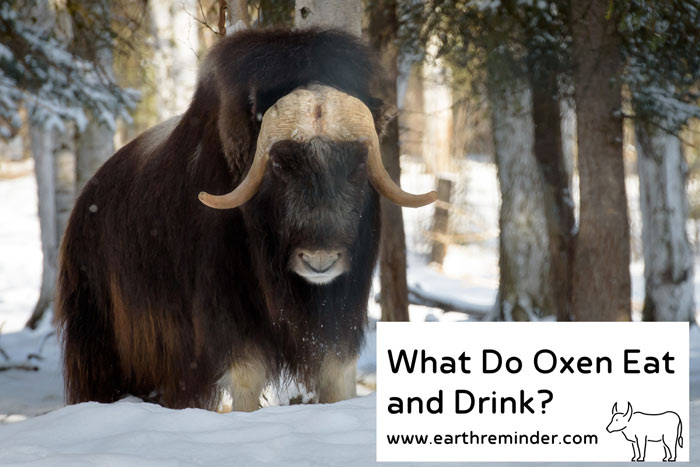What Do Oxen Eat and Drink? – Oxen Diet
For centuries, oxen have been used as “beasts of burden” animals for plowing fields and carrying heavy loads. They are ideal for farm work because of their strength and endurance, but like all animals, they require a proper diet in order to remain healthy and perform at their best. Generally, oxen eat forage (hay or grass) and grain (corn or oats), but the exact proportions depend on their age, weight, and level of activity. Here, we’ll take a closer look at what oxen eat and how their diet affects them.
Table of Contents
What Do Oxen Eat?
Generally at the age of four, domestic oxen begin working. The steer, or bullock, has been castrated in order to make them easier to handle for teamsters. Since oxen are herbivores, they consume plants and grains. Domesticated oxen eat fresh grass, hay, and grain supplements. Musk-oxen inhabit the Arctic tundra and eat moss, lichen, and roots.
To get food, wild musk oxen burrow through the snow with their hooves. They have thick, shaggy hair that can withstand cold temperatures. To protect themselves against wolves, they live in groups of two or three dozen.
Oxen can also use all the nutrients that plants provide. But, to further strengthen their immune system, you need to complement their diet with enough water, calcium, phosphorus, selenium, magnesium, and other vitamin food supplements. These include organic minerals and enzyme supplements.
What Do Oxen Drink?
Every animal, including oxen, needs water to stay healthy as well as hydrated, including adult males trained for hard work. An ox’s water requirement depends on several factors, like its size, activity level, and the temperature and humidity it’s in.
Oxen may drink between 3 and 30 gallons of water a day, especially during hot weather when they sweat more. Often, they drink water from ponds, rivers, and other natural sources.
Remember that the quality of the water oxen drink is also important. Their health depends on clean, fresh water, and polluted or contaminated water can make them sick. In order to maintain their health, treating the water and offering an alternative supply of water is occasionally necessary.
What do Oxen Eat In the Winter?
Over millennia, oxen have been domesticated for their power and adaptability. When winter approaches, many farmers wonder what to feed their oxen. Oxen need a specific diet in winter to maintain their well-being and health. Information on what oxen consume during winter is provided below:
Grains
Oxen may be fed grains like corn, oats, or barley to increase their nutrient intake. The grains are packed with vitality and give the animal the nutrients it needs to keep its body in a healthy shape. They also help it stay warm in chilly weather.
Forage
During winter, oxen may graze on a range of forages, including hay, straw, and silage. These foods provide the animal’s digestive system with fiber and roughage. A variety of plants, such as grass, alfalfa, and clover, can be used as source materials for hay and straw.
Oxen usually eat hay in the winter since it’s easy to store and has plenty of nutrition, so it’s the most common food in the winter. A barn or other shelter stores dried grasses and plants, which are then fed to the oxen as needed.
Mineral Supplements
To sustain their general health, oxen need particular minerals including calcium, phosphorus, and salt. Their diet can include nutritional supplements in the form of blocks or loose minerals. These vitamins keep bones, teeth, and muscles strong.
Water
In the winter, it is crucial that their water supply does not freeze and that they have access to fresh, clean water. Throughout the winter, dehydration can be a major problem for animals. Don’t forget to fill up your oxen’s water source and change it regularly.
Oxen can digest above discussed feeds more easily if they are made into a mash or pellet. Remember to give everything in moderation.
Also Read: Importance Of Domestic Animals in Our Lives.
What Do Musk Oxen Eat?
Musk oxen are herbivores, which means they eat primarily plants. They consume grasses, sedges, and forbs in the summer. Additionally, they can dig beneath the surface of the snow to find plants that they eat. The majority of their winter diet is composed of woody shrubs and plants that survive cold weather. Additionally, they also eat lichens and mosses.
Musk oxen can also find food in areas where other animals cannot. They are able to dig up frozen roots and tubers during winter, which can provide them with much-needed energy.
Also Read: Different Types of Domestic Animals.
Conclusion
Oxen are noted for their strength and capacity to pull heavy loads, and they are frequently used as draft animals in agriculture. As ruminants, oxen digest a variety of foods. They are also herbivores; hay, grass, and grains like corn or oats comprise most of their diet. Oxen also enjoy eating roots and tubers such as potatoes, turnips, and carrots, as well as fruits like apples and pears in moderation. There are also other plants and forages that can be consumed, depending on their availability and nutritional value. To preserve their strength and health, oxen need to eat a nutritious and balanced diet. Thus, it is recommended that they have access to clean water and high-quality foods, including hay, grains, and fresh forages.

